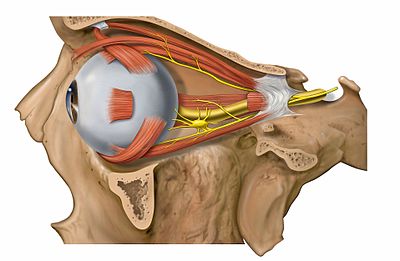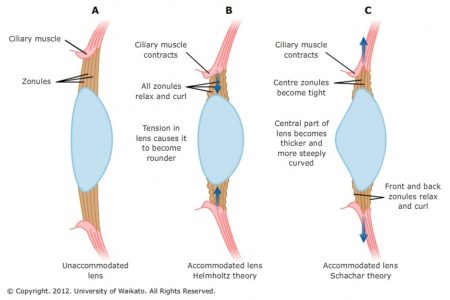A subscriber to my twice-a-month newsletter sent me this question yesterday. The extra-ocular muscles surround the eyeball (see the drawing). Extra-ocular literally means “outside the eye”. These are the muscles you’re using if you turn your eyes to look to the left, or the right, or up, or down. Dr. Bates taught that tight strained extra-ocular muscles are responsible for vision difficulties. He said that as we strain and struggle and force our eyes to see, these muscles get over-used and tired from working so hard, which leads to the eyeball being misshapen, and to poor sight. And we can’t only focus on this one facet of vision.
A classic vision exercise recommended for astigmatism, where the cornea or front of the eye becomes irregularly curved, is eye circles, to gently stretch the extra-ocular muscles. (To read more about astigmatism, see this.) If you try some slow easy eye circles, you might be surprised to find that moving your eyes in one arc of the circle feels more stiff and tense than elsewhere around the circle. This is just like an unused muscle which wakes up in the gym — you want to go slowly here, not push it! The woman who asked this question wrote that she tried eye circles, and “afterwards, my eyes felt very tired and somewhat strained”. This doesn’t mean it’s harming her, only that she needs to proceed more slowly or gently.

There are other tiny muscles which surround the lens at the front of the eye. These little ciliary muscles relax to let the lens flatten for looking in the distance, or tense to pull on the lens so it will bulge rounder for closer vision. Focusing near, then far, then near, then far, again gently and without straining, will tone these muscles and help your vision. The relationship between the ciliary muscles and the extra-ocular ones isn’t obvious, but it’s my feeling there is one. The body is one integrated intelligent system, all parts in communication with each other.
In Dr. Bates’ time, and still to a large degree today, the prevailing theory of how eyesight worked centered on the lens of the eye. Dr. Bates’ theories about the extra-ocular muscles were met with a great deal of opposition. Personally, I almost don’t care who is right, and maybe both are. I just want clear healthy relaxed vision, and for all parts of my eyes to be functioning correctly, for both near and far vision.

Here’s one possibility. Let’s say as a child I’m nervous and straining to see. I don’t really want to see because I’m so scared. Looking in the distance, my lens flattens but not enough because I’m very tense — the ciliary muscles can’t relax enough to give me clarity. So my extra-ocular muscles try to help, and squeeze my eyeball forward, temporarily giving me the typical myopic long eyeball. Then I get put in distance eyeglasses, told to wear them all the time even for close work, and my downhill slide of progressive myopia begins.
I think the best “vision practice” is not to target particular muscles too much, but to just practice seeing in different conditions. Go for a stroll and look at the mountains in the distance, or the clouds overhead. Then look at a flower at your feet. Watch a car going by — how far away does it have to be before you can’t see the details? Enjoy the bright sunshine, and walking through your neighborhood after dark, noticing what you can see in each case.
If you do some eye circles and find looking up and to the right is very sore, yes, do some gentle stretching of those muscles. And don’t forget your overall body health of good nutrition and proper hydration and sufficient rest, since this will help your vision too. Check in with your attitude also. Maybe your eyes don’t want to see that you’re stuck in a job where you hate your boss. Vision exercises won’t help that!
Your eyes, and the rest of your body, are giving you feedback all the time about how you’re functioning, and how well you’re interacting with your environment. Pay attention to what your eyes are saying they need, which is usually either more rest, or more or different stimulation. Then give that to them, to the best of your ability. When you can see well consistently, you will be well.
get help on our Facebook Group!
I wore strong glasses, then contact lenses, from age 5 into my 40s. While making many mistakes, eventually l learned how to improve the way I use my eyes and to see in a more relaxed, healthy manner. It is my pleasure to coach others to do the same. Visit me at https://NancyLNeff.com.
